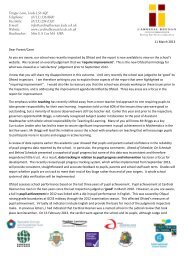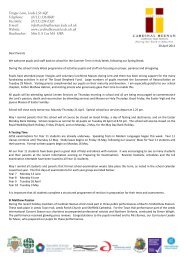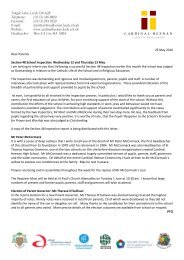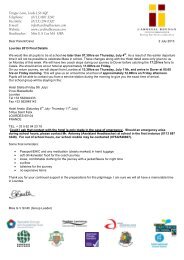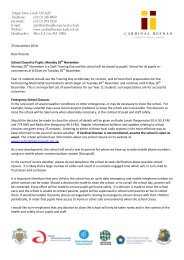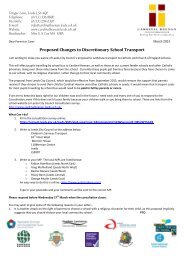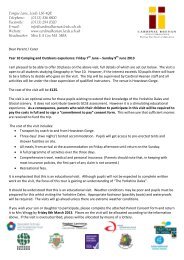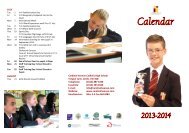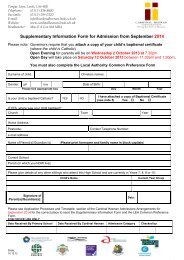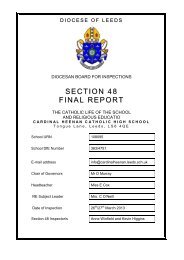Learning at Cardinal Heenan - Cardinal Heenan Catholic High School
Learning at Cardinal Heenan - Cardinal Heenan Catholic High School
Learning at Cardinal Heenan - Cardinal Heenan Catholic High School
You also want an ePaper? Increase the reach of your titles
YUMPU automatically turns print PDFs into web optimized ePapers that Google loves.
<strong>Learning</strong> <strong>at</strong><strong>Cardinal</strong> <strong>Heenan</strong>:A Parents’ Guide2012 – 2013
2 2012-2013
Dear Parent,This commentary sets out the work undertaken in school to raisestandards for all pupils. Please read it carefully. The school reliesupon the support of parents in helping pupils to reach their fullpotential.ContentsPage4 Target Setting5 Progress Reports and Tracking Your Child’s Progress6 <strong>Learning</strong> and Teaching: Assessment for <strong>Learning</strong>11 Attainment and Attendance11-12 Homework and Examin<strong>at</strong>ion Coursework14-23 Key D<strong>at</strong>es and <strong>School</strong> Assessment Inform<strong>at</strong>ion2012-2013 3
Target SettingEvery pupil is set a target rel<strong>at</strong>ing to academic <strong>at</strong>tainment for the end of the school year inevery subject. These targets, set by the teacher and agreed with the pupil, are bothchallenging and aspir<strong>at</strong>ional. Every pupil is closely involved in agreeing targets.The targets set in each subject are based on: Wh<strong>at</strong> your child has already achieved The expected progress of your child. This is based on the progress of pupils acrossthe country who have similar ability to your child.In Years 7 and 8 your child’s target will be expressed as a N<strong>at</strong>ional Curriculum Level, subdividedinto three parts where ‘a’ is the highest third of the level, ‘b’ is the middle and ‘c’the lowest (e.g. 5a is the highest third of level 5; 6c is the lowest third of level 6 etc.)Most pupils enter Year 7 having achieved Level 4 in English, M<strong>at</strong>hs and Science in their KeyStage 2 tests. However, there will always be some pupils below and others beyond thisLevel. Levels 5 and 6 are the N<strong>at</strong>ional Curriculum targets set for pupils <strong>at</strong> the end of Year 9,and it is expected th<strong>at</strong> pupils will progress by one or two Levels between Years 7 and 9.The school sets challenging targets and is implementing str<strong>at</strong>egies to ensure pupilsprogress well during their time here.In Years 9, 10 and 11 targets will be expressed as GCSE grades (one of: A*, A, B, C, D, E, F,or G where A* is the highest grade). Voc<strong>at</strong>ional course grades are: Distinction (Dn), Merit(M) and Pass (P).Your child’s target grades for the end of the school year are shown in the Planner on pages145 (for pupils in Years 7 to 9) and 146 (for pupils in Years 10 and 11).Pupil progress will be reviewed formally each term to ensure th<strong>at</strong> your child is making goodprogress towards his or her targets. A target may be revised upwards if the pupil is makingfaster progress than expected. Targets and progress being made towards them will bediscussed regularly with pupils and you, their parents.You will be informed about your child’s progress in the Progress Report which will be senthome each term.Teachers will: Encourage pupils to assess their progress towards their targets Help pupils to understand wh<strong>at</strong> they have to do to improve. Report the progress of pupils towards targets to parents each term.Pupils will: Agree targets for improvement with teachers Assess their own progress and seek advice if they are unsure about wh<strong>at</strong> to do toimprove.4 2012-2013
Parents please: Familiarise yourself with your child’s targets in each subject (see the Pupil Plannerpages 145 and 146) Encourage your child to work hard to reach his or her targets Follow your child’s progress through the termly Progress Report which will be senthome to you Make sure th<strong>at</strong> your child knows wh<strong>at</strong> he or she needs to do to improve.Reaching the TargetsTarget setting <strong>at</strong> <strong>Cardinal</strong> <strong>Heenan</strong> C<strong>at</strong>holic <strong>High</strong> <strong>School</strong> is designed to ensure th<strong>at</strong>appropri<strong>at</strong>e progression is made by all pupils. It is important to note th<strong>at</strong> a target is notseen as a limit. Every child is encouraged to exceed the expected level. Clearly, the systemcannot take account of personal and social influences th<strong>at</strong> may affect a child’s learning. It isvery important th<strong>at</strong> school and home work together closely to address any issues th<strong>at</strong> mayact as a barrier to learning. It is up to every pupil to work hard and give of their best.Progress Reports and Tracking Your Child’s ProgressA termly progress report will inform you whether your child has made progress towards <strong>at</strong>arget.The Progress Report will contain:1. A summary of your child’s <strong>at</strong>tendance record. This is included because there is a closerel<strong>at</strong>ionship between good progress and high <strong>at</strong>tendance levels <strong>at</strong> school.2. A profile of your child’s current level of <strong>at</strong>tainment (in GCSE grades, voc<strong>at</strong>ion course orthe n<strong>at</strong>ional curriculum sub levels described above) for every subject studied.3. The target for the end of the school year th<strong>at</strong> has been set and agreed in every subject.4. A comment for every subject which reports how your child is progressing towards thetarget for the end of the school year. Your child may receive one of three comments foreach subject: Ahead of schedule (Making progress above the level required to meet the end ofyear target) On schedule (Making progress in line with meeting the end of year target) Behind schedule (Making progress below the level required to meet the end of yeartarget)5. An <strong>at</strong>titude to learning grade. Based on your child’s <strong>at</strong>titudes to work, both in theclassroom and in independent study and homework, this grade gives an indic<strong>at</strong>ion ofhow your child is working and demonstr<strong>at</strong>es where improvements are necessary.A system of rewards recognises the achievement of those pupils who are on course tomeet their targets in most subjects. Similarly, a system of support helps pupils who are notmaking sufficient progress.The d<strong>at</strong>es when Progress Grades will be sent home are shown on the pages <strong>at</strong> the back ofthis booklet.2012-2013 5
<strong>Learning</strong> and Teaching: Assessment for <strong>Learning</strong> (AfL)Assessment for <strong>Learning</strong> is a n<strong>at</strong>ional str<strong>at</strong>egy to improve learning and raise standards.At <strong>Cardinal</strong> <strong>Heenan</strong> AfL is central to the plan to raise standards for each individual pupil inthe school, regardless of the starting point, and is linked closely with Target Setting andTracking Pupil Progress through the Progress Report.Assessment for <strong>Learning</strong> provides a framework in which educ<strong>at</strong>ional objectives are set andpupils’ progress is charted and expressed in written feedback. It is an integral part of thelearning process <strong>at</strong> <strong>Cardinal</strong> <strong>Heenan</strong>, and provides pupils with both “feedback” and“feedforward” (informing pupils of wh<strong>at</strong> they need to do next).Principles of Assessment for <strong>Learning</strong> (AfL)The principles of teaching and learning are:including all pupils in a culture of high expect<strong>at</strong>ions (no child left behind);establishing the importance of literacy and numeracy across the curriculum(reinforcing the basics);infusing learning skills across the curriculum (enriching the learning experience);promoting assessment for learning (meeting the needs of every individual child);expanding the teacher’s range of teaching str<strong>at</strong>egies and techniques (making learningworthwhile and enjoyable).Assessment for <strong>Learning</strong> involves teachers <strong>at</strong> this school identifying the next steps forlearning as well as responding to the errors pupils make and the difficulties theyexperience.Assessment for <strong>Learning</strong>Assessment for <strong>Learning</strong> gets straight to the heart of good teaching because:teachers help pupils to take the next steps in their learning;pupils help each other to take the next steps in their learning;pupils help themselves to take the next steps in their learning.Learners see where their knowledge gap is and they are helped by teachers to developstr<strong>at</strong>egies to close the gap.Essential to good Assessment for <strong>Learning</strong> are:the sharing of learning objectives and outcomes with pupilspupils’ peer and self assessmentfeedback to pupils to inform next steps in learning.6 2012-2013
Why Objective Led Lessons?A key part of teaching and learning <strong>at</strong> <strong>Cardinal</strong><strong>Heenan</strong> is the sharing of lesson objectives <strong>at</strong>the start of lessons. Learners will be clearabout wh<strong>at</strong> they are going to do, and they willknow the learning outcomes and successcriteria.Lesson objectives are displayed in theclassroom and revisited throughout thelesson. At the end of the lesson they are againre-visited to ensure th<strong>at</strong> pupils can see wh<strong>at</strong>progress they have made. Teachers may showexamples of wh<strong>at</strong> a good answer looks like –this may even be the work of another pupil.This modelling helps pupils to understandwh<strong>at</strong> they can do to improve their work.LEARNING BOARDWeAre<strong>Learning</strong>To……Remember to…………LEARNING BOARDWh<strong>at</strong>I’mLookingForRemember to…………Assessment for <strong>Learning</strong> not Assessment of <strong>Learning</strong>Another important aspect of teaching and learning rel<strong>at</strong>es to written feedback provided byteachers. The school has involved staff and pupils in devising a Feedback Policy th<strong>at</strong> willhelp all our pupils to have a very clear understanding of wh<strong>at</strong> they do well and wh<strong>at</strong> theyneed to do to improve.Parents will continue to see evidence in their child’s books of some use of ticks andnumerical scores for certain types of work (in history, m<strong>at</strong>hem<strong>at</strong>ics and science, forexample). Clearly, teachers cannot give detailed written comments on every piece of work.However, your child will receive <strong>at</strong> least one piece of quality written feedback each halfterm. Form<strong>at</strong>ive assessment of this kind will allow learners to understand how they canmake progress and should encourage them to take responsibility for their learning, therebymaking them more independent learners.The different approaches allow the teacher to assess wh<strong>at</strong> the child has learnt in the lesson– oral feedback, instant feedback via mini whiteboards, Fingers of Five and Traffic Lights(see the next page) . The school is also developing more effective questioning techniqueswhich will pose open ended questions th<strong>at</strong> allow time for pupil reflection before an answeris given.2012-2013 7
Fingers of Five5You confidently understand the ideas (but you understood alot already).4 You confidently understand the new ideas.321You understand most of the ideas (a bit more practice wouldmake you confident).You do not understand the ideas (but you know which bitsyou do not understand).You do not understand the ideas (and you are not sure wh<strong>at</strong>it is you do not understand).Traffic LightsAn altern<strong>at</strong>ive str<strong>at</strong>egy is to ask pupils to ‘traffic light’ their work.Here’s how this works.The pupils are given green, red and yellow pens or pieces of card. Pupils who believe th<strong>at</strong> they have achieved the learning objective andth<strong>at</strong> they could explain it to another pupil show green. Those who are fairly confident but there might be one or two areasthey want to work on display yellow. Those who think th<strong>at</strong> they need more help and support in achievingthis objective display red.Teachers ask the pupils to elabor<strong>at</strong>e on their decisions with examples orevidenceThis str<strong>at</strong>egy provides valuable feedback on how the pupils haveresponded to the work and how well they have understood wh<strong>at</strong> hasbeen taught.8 2012-2013
Why Quality Oral and Written Feedback?Teachers talk to pupils about how they can improve their work. They teach pupilshow to assess their own and each other’s work and how to improve it. The EnglishDepartment has produced guidance for all staff and pupils on effective peer andself assessment.And FinallyThe most important thing is th<strong>at</strong> learners and their parents understand the writtenfeedback they receive. To help with this all the teachers in the school have agreedhow to mark pupils’ work. We are committed to producing feedback th<strong>at</strong>encourages children to improve and tells them how to do it.You can see your work is goodand your teacher backs it up.Pupils like knowing. It helps them tolearn.It helps you remember wh<strong>at</strong>you are doing - “if you thinkyou can look on the board”The teachers have put WALTand WILF on a learning board inmost lessons so we know wh<strong>at</strong>we are learning.We’re normally given anobjective…...the aim of thelesson. In English we have to write it in ourjournals.You get an idea of wh<strong>at</strong>you’re supposed to bedoing.When you are doingit, you can put itright. It makes youfeel good.When we havedone well we walkout of the lessonknowing th<strong>at</strong> welearnt somethingand we have hadfun.2012-2013 9
Before AfLAfter AfLWh<strong>at</strong> shall I mark fortoday? It takes meso long and theynever look <strong>at</strong> it!Now I use thelearning criteria,my marking isquicker and makesa difference.I wonder howwe get a goodmark?Now I know wh<strong>at</strong> I am learning andmy work is good and I am giventime to make it better.I know how to do itbetter!I wonder if theyhave learnt it.They have donethe task.Today we are learningto...My pupils are ontask and I can seeth<strong>at</strong> they arelearning.I wonder wh<strong>at</strong>it is he wantsus to learn?Now I know wh<strong>at</strong> Iam learning and mywork is good.I know wh<strong>at</strong> todo and why!10 2012-2013
Attainment and AttendanceThere is a direct link between achievement and regular <strong>at</strong>tendance. All pupils in school willbe made aware of their <strong>at</strong>tendance percentage every term and will be placed in one ofthree Traffic Light zones. Our “Go Green” <strong>at</strong>tendance initi<strong>at</strong>ive encourages every pupil toaim for improvements and consistency in terms of regular <strong>at</strong>tendance and excellentpunctuality.Red is under 84% <strong>at</strong>tendanceAmber is for those between 85% and 94%Green is over 95% and will ensure maximum success in terms of reaching targets and goals.Every new term is a fresh start as this gives pupils the opportunity to take gre<strong>at</strong>erresponsibility for raising their <strong>at</strong>tendance and improving their chances of reaching theirpotential. A fresh start also acknowledges the fact th<strong>at</strong> a small number of pupils who havehad genuine reasons for absence in one term can rapidly get back on track and make theprogress expected of them.A summary of every pupil’s <strong>at</strong>tendance and absence and Traffic Light zone will be issuedthree times a year as part of the Progress Report. Seventeen days absence over any oneyear period equ<strong>at</strong>es to one grade lost <strong>at</strong> GCSE* and indic<strong>at</strong>es the impact of absences,wh<strong>at</strong>ever the year group.Please ensure th<strong>at</strong> your child <strong>at</strong>tends regularly.* Department of Children, <strong>School</strong>s and Families.HomeworkDeveloping the Skills for Independent StudyHomework is a very important part of the school curriculum since it helps pupils to developself-motiv<strong>at</strong>ion and to work independently - skills which are essential for success in l<strong>at</strong>erlife. Pupils will gain maximum benefit from homework if they adopt a methodical,disciplined approach. Please provide a quiet time and place to enable homework to becompleted to the best of your child’s ability. A standard routine each evening, with aminimum of other distractions, will ensure th<strong>at</strong> pupils gain the maximum benefit fromhomework and their studies as a whole.Using the PlannerThe work set for each evening should be recorded by your son or daughter in his or herPlanner. Please check th<strong>at</strong> the homework is completed and sign the Planner in the'Parents’ Comments' section each weekend to indic<strong>at</strong>e th<strong>at</strong> this is the case. Please feelfree to add any comments of your own. This can provide the tutor and subject teacherwith useful inform<strong>at</strong>ion.2012-2013 11
Homework <strong>at</strong> Key Stage 3 (Years 7 and 8)Each week subject teachers will set one homework assignment in each of their schoolsubjects. The homework tasks for each subject should take pupils about 30 minutes tocomplete, as a minimum. The type of homework will vary from subject to subject and fromweek to week and may include written work, reading, learning or library research. In somesubjects, extended projects will be set. These may last several weeks.Homework <strong>at</strong> Key Stage 4 (Years 9, 10 and 11)The amount of homework which individuals will receive depends on the types of coursewhich they are following but, as a guide, pupils should complete approxim<strong>at</strong>ely one hourper week for each of their Key Stage 4 examin<strong>at</strong>ion subjects. Part of this time will involvecarrying out prepar<strong>at</strong>ion for controlled assessments, coursework projects and assignmentsas well as revision for tests and assessments.<strong>High</strong> levels of commitment <strong>at</strong> home are essential if deadlines are to be met.Many of the public examin<strong>at</strong>ion courses <strong>at</strong> Key Stage 4 (GCSE, BTEC, OCR and CambridgeN<strong>at</strong>ionals etc.) involve pupils completing set pieces of work (known as controlledassessments in some subjects and as coursework in others) throughout the three years ofstudy. The work is assessed by the subject teacher and the marks contribute to the finalexamin<strong>at</strong>ion grade or level.The type of controlled assessment or coursework varies from subject to subject and mayinclude: project work th<strong>at</strong> can last several weeks; shorter written assignments th<strong>at</strong> may beset weekly; and controlled assessments th<strong>at</strong> take place during lesson time.In most Key Stage 4 subjects the controlled assessments and coursework begins in Year 9and continues throughout Years 10 and 11. Success in this continuous assessmentdepends upon pupils being able to work to deadlines and to avoid the build-up of a largebacklog of incomplete work.12 2012-2013
Key Assessment D<strong>at</strong>esPage14-15 Year 716-17 Year 818-19 Year 920-21 Year 1022-23 Year 112012-2013 13
Key Assessment D<strong>at</strong>es for Year 7Parents EveningThursday 28 February 2013 (Subject Teachers)Written Report Wednesday 17 July 2013Progress Reports Autumn Term Wednesday 19 December 2012Spring Term Wednesday 27 March 2013Summer Term Wednesday 17 July 201314 2012-2013
KEY:CHAControlled Assessment in examin<strong>at</strong>ion conditionsHomework: important assessmentAssessmentTTestResults of all the above key tasks will inform teachers' judgements of progresstowards Target Grades.2012-2013 15
Key Assessment D<strong>at</strong>es for Year 8Parents Evening Wednesday 30 January 2013 (Subject Teachers)Written Report Wednesday 17 July 2013ProgressReportsAutumn TermSpring TermSummer TermWednesday 19 December 2012Wednesday 27 March 2013Wednesday 17 July 201316 2012-2013
KEY:HATHomework: important assessmentAssessmentTestResults of all the above key tasks will inform teachers' judgements of progresstowards Target Grades.2012-2013 17
Key Assessment D<strong>at</strong>es for Year 9Parents Evening Tuesday 19 March 2013 (Subject Teachers)Written Report Wednesday 17 July 2013Progress Reports Autumn TermSpring TermSummer TermWednesday 19 December 2012Wednesday 27 March 2013Wednesday 17 July 2013KEY:EXHATGCSE Examin<strong>at</strong>ions in Sports HallHomework to be assessed for BTEC or OCR N<strong>at</strong>ionalsAssessmentTestSp T GCSE Speaking TestResults of all the above key tasks will inform teachers' judgements of progresstowards Target Grades.18 2012-2013
2012-2013 19
Key Assessment D<strong>at</strong>es for Year 10Parents’ Evening Thursday 28 February 2013 (Subject Teachers)Written Report Wednesday 17 July 2013Progress Reports Autumn Term Wednesday 19 December 2012Spring Term Wednesday 27 March 2013Summer Term Wednesday 17 July 2013KEY:EXCHATSp TGCSE Examin<strong>at</strong>ions in Sports HallControlled Assessment for GCSE or Coursework Assignment for BTEC orOCR N<strong>at</strong>ionalsHomework to be assessed for BTEC or OCR N<strong>at</strong>ionalsAssessmentTestGCSE Speaking TestInternal Examin<strong>at</strong>ions & AssessmentsResults of all the above key tasks will inform teachers' judgements of progresstowards Target Grades.20 2012-2013
2012-2013 21
Key Assessment D<strong>at</strong>es for Year 11GCSE Mock Examin<strong>at</strong>ions: Friday 30 November—Friday 14 December 2012(in Sports Hall). All students should be in school during this period.Parents’ Evening Tuesday 15 November 2012 (Subject Teachers)Written Report Wednesday 27 February 2013Progress ReportsAutumn Term Friday 9 November 2012Spring Term Wednesday 28 March 2013Summer Term Year 11 Will not receive a Summer Term Progress ReportKEY:EXCHATGCSE Examin<strong>at</strong>ions in Sports HallControlled Assessment for GCSE or Coursework Assignment for BTECor OCR N<strong>at</strong>ionalsHomework to be assessed for BTEC or OCR N<strong>at</strong>ionalsAssessmentTestSp TGCSE Speaking TestResults of all the above key tasks will inform teachers' judgements of progresstowards Target Grades.22 2012-2013
2012-2013 23
ResourcesWebsites of Examining BodiesAssessment and Qualific<strong>at</strong>ions Alliance (AQA)Oxford, Cambridge and RSA (OCR)Edexcelwww.aqa.org.ukwww.ocr.org.ukwww.edexcel.org.ukThese examining bodies offer a range of useful resources, including full syllabuses,exemplar question papers, student guides, samples of controlled assessment andcoursework tasks etc.Revision GuidesSeveral companies produce popular revision guides, including :Collins Educ<strong>at</strong>ional PublishersCo-ordin<strong>at</strong>ion Group Public<strong>at</strong>ionLonsdale <strong>School</strong> Revision Guideswww.collinseduc<strong>at</strong>ion.comtel : 0870 787 1612www.cgpbooks.co.uktel: 0870 750 1252www.lonsdalesrg.co.uktel: 015242 72413Help With Revisionhttp://lgfl.skoool.co.uk (Note: three "O"s)www.rudimentsofwisdom.comwww.bbc.co.uk/schools/gcsebitesize/An excellent site: M<strong>at</strong>hs andScience learning/revisionresources, including good use ofanim<strong>at</strong>ionFacts in cartoon form. Wide rangeof subjects.'Bitesize' revision topics, includinggames, in most curriculum subjectswww.channel4.com/learning/teachers/websites/ Help with homework and revision inmany subjects.www.s-cool.co.ukGCSE revision: English, French,Geography, M<strong>at</strong>hs, PE, Science,Technology (Food)



